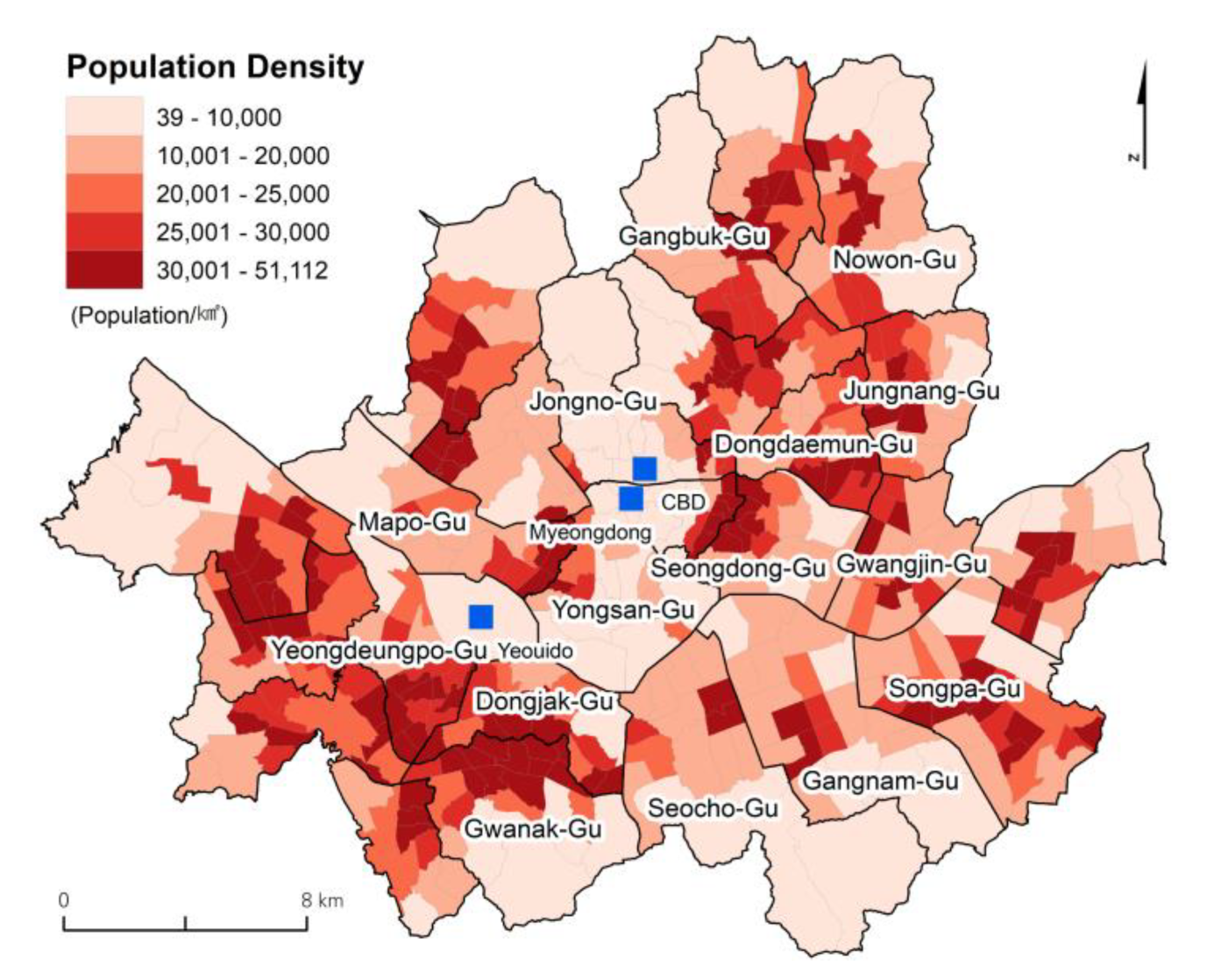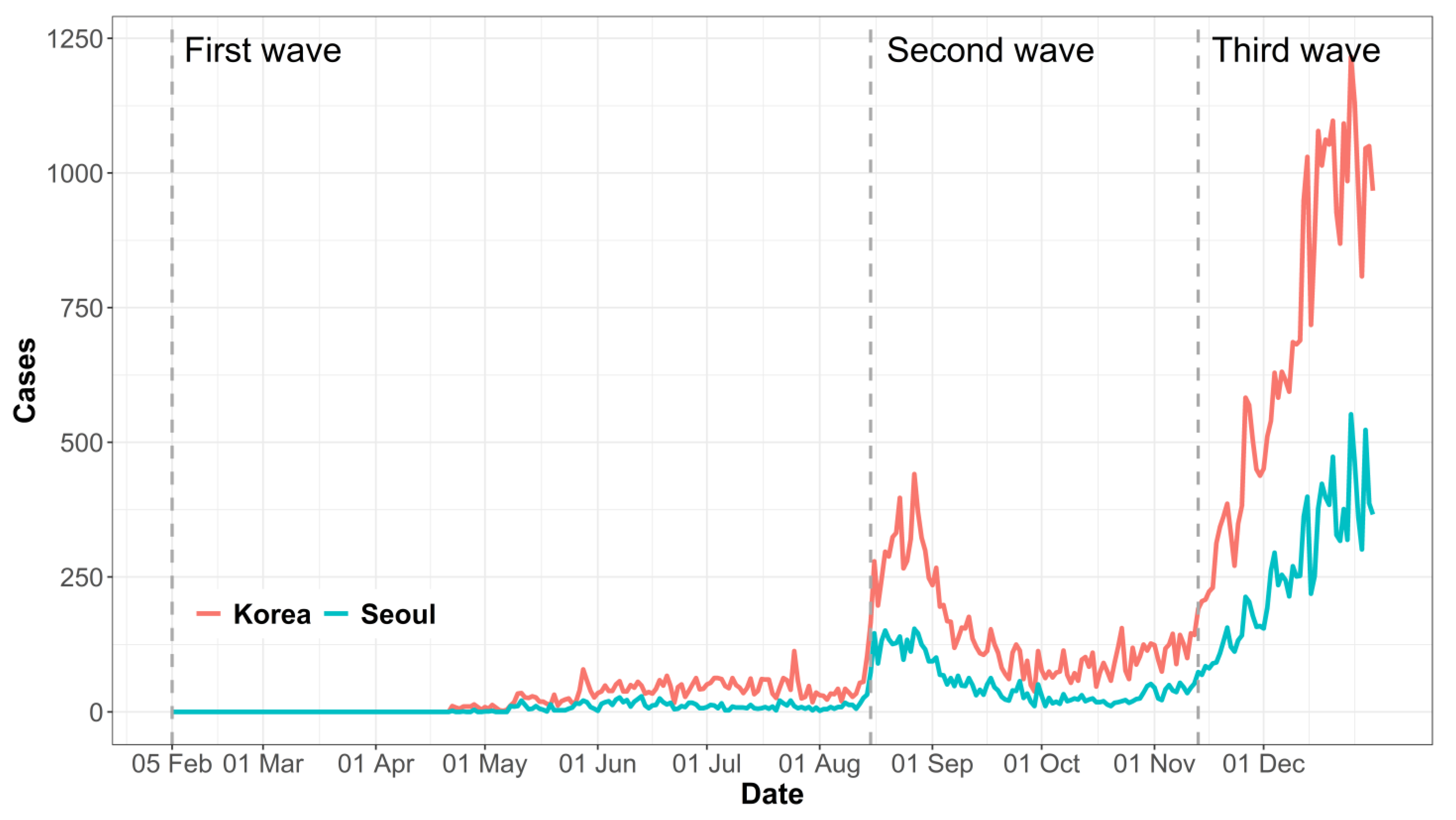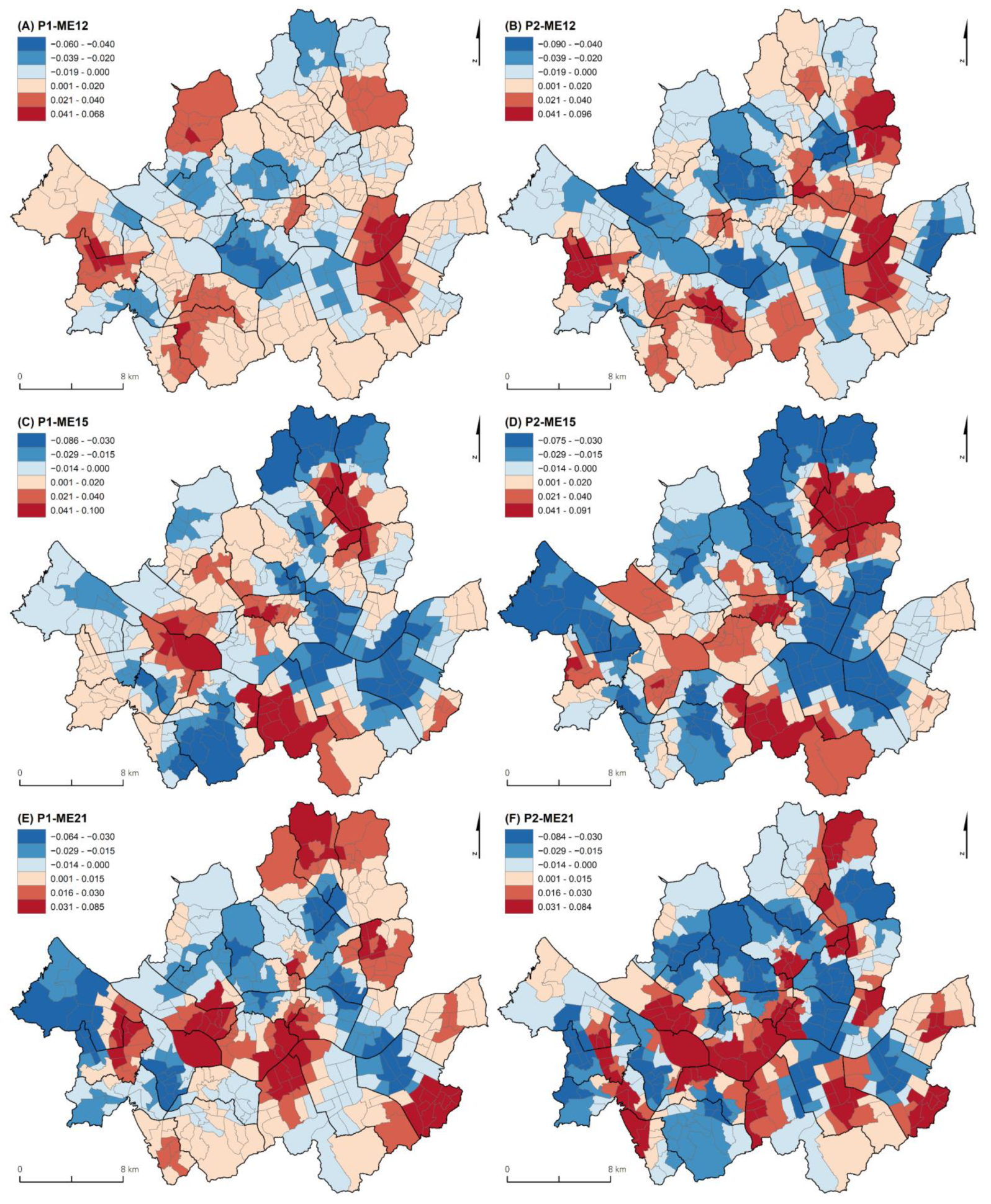Spatio-Temporal Variability of the Impact of Population Mobility on Local Business Sales in Response to COVID-19 in Seoul, Korea
Abstract
:1. Introduction
2. Changes in COVID-19 Status and Social Distancing Policy
3. Materials and Methods
3.1. Data
3.2. Methods
4. Results
4.1. Data Exploration and Global Linear Regression
4.2. Exploring Temporal Difference Using Statistical Interaction Terms
4.3. Exploring Spatio-Temporal Difference Using ESF-SVC with Statistical Interaction Terms
5. Conclusions
Supplementary Materials
Author Contributions
Funding
Institutional Review Board Statement
Informed Consent Statement
Data Availability Statement
Conflicts of Interest
Appendix A


References
- Drake, T.M.; Docherty, A.B.; Weiser, T.G.; Yule, S.; Sheikh, A.; Harrison, E.M. The Effects of Physical Distancing on Population Mobility during the COVID-19 Pandemic in the UK. Lancet Digit. Health 2020, 2, e385–e387. [Google Scholar] [CrossRef]
- Bonaccorsi, G.; Pierri, F.; Cinelli, M.; Flori, A.; Galeazzi, A.; Porcelli, F.; Schmidt, A.L.; Valensise, C.M.; Scala, A.; Quattrociocchi, W.; et al. Economic and Social Consequences of Human Mobility Restrictions under COVID-19. Proc. Natl. Acad. Sci. USA 2020, 117, 15530–15535. [Google Scholar] [CrossRef] [PubMed]
- Pepe, E.; Bajardi, P.; Gauvin, L.; Privitera, F.; Lake, B.; Cattuto, C.; Tizzoni, M. COVID-19 Outbreak Response, a Dataset to Assess Mobility Changes in Italy Following National Lockdown. Sci. Data 2020, 7, 3–9. [Google Scholar] [CrossRef]
- Nouvellet, P.; Bhatia, S.; Cori, A.; Ainslie, K.E.C.; Baguelin, M.; Bhatt, S.; Boonyasiri, A.; Brazeau, N.F.; Cattarino, L.; Cooper, L.V.; et al. Reduction in Mobility and COVID-19 Transmission. Nat. Commun. 2021, 12, 1–9. [Google Scholar] [CrossRef] [PubMed]
- Kraemer, M.U.G.; Yang, C.H.; Gutierrez, B.; Wu, C.H.; Klein, B.; Pigott, D.M.; du Plessis, L.; Faria, N.R.; Li, R.; Hanage, W.P.; et al. The Effect of Human Mobility and Control Measures on the COVID-19 Epidemic in China. Science 2020, 368, 493–497. [Google Scholar] [CrossRef]
- Badr, H.S.; Du, H.; Marshall, M.; Dong, E.; Squire, M.M.; Gardner, L.M. Association between Mobility Patterns and COVID-19 Transmission in the USA: A Mathematical Modelling Study. Lancet Infect. Dis. 2020, 20, 1247–1254. [Google Scholar] [CrossRef]
- Parino, F.; Zino, L.; Porfiri, M.; Rizzo, A. Modelling and Predicting the Effect of Social Distancing and Travel Restrictions on COVID-19 Spreading. J. R. Soc. Interface 2021, 18, 20200875. [Google Scholar] [CrossRef]
- Lewnard, J.A.; Lo, N.C. Scientific and Ethical Basis for Social-Distancing Interventions against COVID-19. Lancet Infect. Dis. 2020, 3099, 631–633. [Google Scholar] [CrossRef]
- Wellenius, G.A.; Vispute, S.; Espinosa, V.; Fabrikant, A.; Tsai, T.C.; Hennessy, J.; Dai, A.; Williams, B.; Gadepalli, K.; Boulanger, A.; et al. Impacts of Social Distancing Policies on Mobility and COVID-19 Case Growth in the U.S. Nat. Commun. 2021, 12, 6–12. [Google Scholar] [CrossRef]
- De Vos, J. The Effect of COVID-19 and Subsequent Social Distancing on Travel Behavior. Transp. Res. Interdiscip. Perspect. 2020, 5, 100121. [Google Scholar] [CrossRef] [PubMed]
- Jenelius, E.; Cebecauer, M. Impacts of COVID-19 on Public Transport Ridership in Sweden: Analysis of Ticket Validations, Sales and Passenger Counts. Transp. Res. Interdiscip. Perspect. 2020, 8, 100242. [Google Scholar] [CrossRef] [PubMed]
- Kim, J.; Kwan, M.P. The Impact of the COVID-19 Pandemic on People’s Mobility: A Longitudinal Study of the U.S. from March to September of 2020. J. Transp. Geogr. 2021, 93, 103039. [Google Scholar] [CrossRef]
- Park, J. Changes in Subway Ridership in Response to COVID-19 in Seoul, South Korea: Implications for Social Distancing. Cureus 2020, 14, e7668. [Google Scholar] [CrossRef] [PubMed]
- Lee, K.; Park, S.; Ham, Y. Changes in Subway Traffic in Seoul during Social Distancing Due to the Spread of COVID-19 and Geographic Characteristics of the Area behind the Station. J. Econ. Geogr. Soc. Korea 2021, 24, 127–142. [Google Scholar]
- Lee, H.; Park, S.J.; Lee, G.R.; Kim, J.E.; Lee, J.H.; Jung, Y.; Nam, E.W. The Relationship between Trends in COVID-19 Prevalence and Traffic Levels in South Korea. Int. J. Infect. Dis. 2020, 96, 399–407. [Google Scholar] [CrossRef]
- Zhu, R.; Anselin, L.; Batty, M.; Kwan, M.P.; Chen, M.; Luo, W.; Cheng, T.; Lim, C.K.; Santi, P.; Cheng, C.; et al. The Effects of Different Travel Modes and Travel Destinations on COVID-19 Transmission in Global Cities. Sci. Bull. 2022, 67, 588–592. [Google Scholar] [CrossRef]
- Carracedo, P.; Puertas, R.; Marti, L. Research Lines on the Impact of the COVID-19 Pandemic on Business. A Text Mining Analysis. J. Bus. Res. 2021, 132, 586–593. [Google Scholar] [CrossRef]
- Pantano, E.; Pizzi, G.; Scarpi, D.; Dennis, C. Competing during a Pandemic? Retailers’ Ups and Downs during the COVID-19 Outbreak. J. Bus. Res. 2020, 116, 209–213. [Google Scholar] [CrossRef]
- Panzone, L.A.; Larcom, S.; She, P.W. Estimating the Impact of the First COVID-19 Lockdown on UK Food Retailers and the Restaurant Sector. Glob. Food Sec. 2021, 28, 100495. [Google Scholar] [CrossRef]
- Fairlie, R. The Impact of COVID-19 on Small Business Owners: Evidence from the First Three Months after Widespread Social-Distancing Restrictions. J. Econ. Manag. Strateg. 2020, 29, 727–740. [Google Scholar] [CrossRef]
- Na, H.; Kim, J.; Ahn, J.; Na, H.; Kim, J.; Ahn, J.; Jun, D.; Im, D. Analyzing Relationships between Floating Population and Card Consuming Data in Seoul before and after COVID-19. Proc. Korea Inf. Process. Soc. Conf. 2021, 28, 301–304. [Google Scholar]
- Lim, S.; Lim, H.; Després, J.P. Collateral Damage of the COVID-19 Pandemic on Nutritional Quality and Physical Activity: Perspective from South Korea. Obesity 2020, 28, 1788–1790. [Google Scholar] [CrossRef] [PubMed]
- Chang, S.-J.; Park, J.-M.; Kang, J.-Y. A Study on the Effect the Infected Number of COVID-19 on the Number of Food Deliveries: Focusing on the Mediating Effect of the National Disaster Fund and Social Distancing. Korea Int. Trade Res. Inst. 2022, 18, 131–147. [Google Scholar] [CrossRef]
- Jin, J.; Seong, B. Analysis of the Differences in Living Population Changes and Regional Responses by COVID-19 Outbreak in Seoul. Korean J. Appl. Stat. 2020, 33, 697–712. [Google Scholar]
- Ryu, E.H.; Kim, E.J. Analysis of the Changes in de Facto Population Pattern and Effects of Local Environment on Changes in the de Facto Population in Seoul after the COVID-19. J. Korean Urban Geogr. Soc. 2021, 24, 19–35. [Google Scholar] [CrossRef]
- Yellow Horse, A.J.; Yang, T.C.; Huyser, K.R. Structural Inequalities Established the Architecture for COVID-19 Pandemic among Native Americans in Arizona: A Geographically Weighted Regression Perspective. J. Racial Ethn. Health Disparities 2022, 9, 165–175. [Google Scholar] [CrossRef]
- Wu, X.; Zhang, J. Exploration of Spatial-Temporal Varying Impacts on COVID-19 Cumulative Case in Texas Using Geographically Weighted Regression (GWR). Environ. Sci. Pollut. Res. 2021, 28, 43732–43746. [Google Scholar] [CrossRef]
- Jiao, J.; Chen, Y.; Azimian, A. Exploring Temporal Varying Demographic and Economic Disparities in COVID-19 Infections in Four U.S. Areas: Based on OLS, GWR, and Random Forest Models. Comput. Urban Sci. 2021, 1, 27. [Google Scholar] [CrossRef]
- Chen, M.; Chen, Y.; Wilson, J.P.; Tan, H.; Chu, T. Using an Eigenvector Spatial Filtering-Based Satially Varying Coefficient Model to Analyze the Spatial Heterogeneity of COVID-19 and Its Influencing Factors in Mainland China. ISPRS Int. J. Geo-Inf. 2022, 11, 67. [Google Scholar] [CrossRef]
- Koo, H. Exploring Spatial Heterogeneity in Factors for Apartment Prices in Seoul Using Moran Eigenvector Spatial Filtering Based on Spatially Varying Coefficients. J. Assoc. Korean Geogr. 2019, 8, 321–335. [Google Scholar] [CrossRef]
- Lee, J.; Kim, G.C. The Smart Transportation Card (T-Money): Integrating Public Transit Systems to Improve Citizen Mobility in Seoul, 1996–2004. Glob. Deliv. Initiat. 2021, 1, 1–12. [Google Scholar]
- Ha, E.; Lee, C.; Koh, M.; Kim, K. The Differential Effect of COVID-19 on Mobility. J. Korean Cartogr. Assoc. 2021, 21, 59–76. [Google Scholar] [CrossRef]
- Yang, S.; Jang, J.; Park, S.Y.; Ahn, S.H.; Kim, S.; Park, S.B.; Ryu, B.; Lee, S.; Shin, E.; Kim, N.-Y.; et al. COVID-19 Outbreak Report from January 20, 2020 to January 19, 2022 in the Republic of Korea. Public Health Wkly. Rep. 2022, 15, 796–805. [Google Scholar]
- Task Force for Tackling COVID-19. All about Korea’s Response to COVID-19; Ministry of Foreign Affairs: Seoul, Korea, 2020. [Google Scholar]
- Madeira, A.; Palrão, T.; Mendes, A.S. The Impact of Pandemic Crisis on the Restaurant Business. Sustainability 2021, 13, 40. [Google Scholar] [CrossRef]
- Lee, J.H.; Park, M.S.; Lee, S. The Transmission Dynamics of SARS-CoV-2 by Setting in Three Waves in the Seoul Metropolitan Area in South Korea. Health Soc. Welf. Rev. 2021, 41, 7–26. [Google Scholar]
- Kim, J.; Ki, D.; Lee, S. Analysis of Travel Mode Choice Change by the Spread of COVID-19: The Case of Seoul, Korea. J. Korea Plan. Assoc. 2021, 56, 113–129. [Google Scholar] [CrossRef]
- James, G.; Witten, D.; Hastie, T.; Tibshirani, R. An Introduction to Statistical Learning with Applications in R; Springer: New York, NY, USA, 2017. [Google Scholar]
- Chun, Y.; Griffith, D.A. Spatial Statistics and Geostatistics: Theory and Applications for Geographic Information Science and Technology; Sage Publications Inc.: London, UK, 2013; ISBN 1446201732. [Google Scholar]
- Koo, H.; Chun, Y.; Griffith, D.A. Modeling Positional Uncertainty Acquired through Street Geocoding. Int. J. Appl. Geospatial Res. 2018, 9, 1–22. [Google Scholar] [CrossRef]
- Franch-Pardo, I.; Napoletano, B.M.; Rosete-Verges, F.; Billa, L. Spatial Analysis and GIS in the Study of COVID-19. A Review. Sci. Total Environ. 2020, 739, 140033. [Google Scholar] [CrossRef]
- Franch-Pardo, I.; Desjardins, M.R.; Barea-Navarro, I.; Cerdà, A. A Review of GIS Methodologies to Analyze the Dynamics of COVID-19 in the Second Half of 2020. Trans. GIS 2021, 25, 2191–2239. [Google Scholar] [CrossRef]
- Helbich, M.; Griffith, D.A. Spatially Varying Coefficient Models in Real Estate: Eigenvector Spatial Filtering and Alternative Approaches. Comput. Environ. Urban Syst. 2016, 57, 1–11. [Google Scholar] [CrossRef]
- Griffith, D.A. Spatial Autocorrelation and Spatial Filtering: Gaining Understanding through Theory and Scientific Visualization; Springer: Berlin/Heidelberg, Germany, 2003; ISBN 3540248064. [Google Scholar]
- Chun, Y.; Griffith, D.A. Modeling Network Autocorrelation in Space-Time Migration Flow Data: An Eigenvector Spatial Filtering Approach. Ann. Assoc. Am. Geogr. 2011, 101, 523–536. [Google Scholar] [CrossRef]
- Chun, Y. Analyzing Space-Time Crime Incidents Using Eigenvector Spatial Filtering: An Application to Vehicle Burglary. Geogr. Anal. 2014, 46, 165–184. [Google Scholar] [CrossRef]
- Tiefelsdorf, M.; Boots, B. The Exact Distribution of Moran’s I. Environ. Plan. A 1995, 27, 985–999. [Google Scholar] [CrossRef]
- Griffith, D.A. Eigenfunction Properties and Approximations of Selected Incidence Matrices Employed in Spatial Analyses. Linear Algebra Appl. 2000, 321, 95–112. [Google Scholar] [CrossRef]
- Wheeler, D.; Tiefelsdorf, M. Multicollinearity and Correlation among Local Regression Coefficients in Geographically Weighted Regression. J. Geogr. Syst. 2005, 7, 161–187. [Google Scholar] [CrossRef]
- Murakami, D.; Lu, B.; Harris, P.; Brunsdon, C.; Charlton, M.; Nakaya, T.; Griffith, D.A. The Importance of Scale in Spatially Varying Coefficient Modeling. Ann. Am. Assoc. Geogr. 2019, 109, 50–70. [Google Scholar] [CrossRef]
- Murakami, D.; Yoshida, T.; Seya, H.; Griffith, D.A.; Yamagata, Y. A Moran Coefficient-Based Mixed Effects Approach to Investigate Spatially Varying Relationships. Spat. Stat. 2017, 19, 68–89. [Google Scholar] [CrossRef]
- Griffith, D.A. Spatial-Filtering-Based Contributions to a Critique of Geographically Weighted Regression (GWR). Environ. Plan. A 2008, 40, 2751–2769. [Google Scholar] [CrossRef]
- Chun, Y.; Griffith, D.A.; Lee, M.; Sinha, P. Eigenvector Selection with Stepwise Regression Techniques to Construct Eigenvector Spatial Filters. J. Geogr. Syst. 2016, 18, 67–85. [Google Scholar] [CrossRef]
- Tiefelsdorf, M.; Griffith, D.A. Semiparametric Filtering of Spatial Autocorrelation: The Eigenvector Approach. Environ. Plan. A 2007, 39, 1193–1221. [Google Scholar] [CrossRef]
- Kim, S.; Kim, Y.J.; Peck, K.R.; Ko, Y.; Lee, J.; Jung, E. Keeping Low Reproductive Number despite the Rebound Population Mobility in Korea, a Country Never under Lockdown during the Covid-19 Pandemic. Int. J. Environ. Res. Public Health 2020, 17, 9551. [Google Scholar] [CrossRef] [PubMed]





| Periods | Changes in Social Distancing Policies | |
|---|---|---|
| Dates | Implemented Policies | |
| First wave | 22 March | Stronger social distancing: postponing or canceling nonessential gatherings, dining out, and travel; in the case of an employer, using flexible work schedules, or adjusting start/end times of work and lunch hours |
| 6 May | Distancing in daily life: harmonizing daily life and infection prevention against the possibility of the long-term prevalence of COVID-19, providing personal guidance suggestions, e.g., staying at home for 3–4 days if unwell and maintaining a distance from others. | |
| 28 June | Implementation of the three-level social distancing policy | |
| Second wave | 16 August | Level 2 of social distancing: avoiding unnecessary outings, meetings, and multi-use facilities; assemblies of no more than 50 people indoors and 100 people outdoors; recommendation of flexible work arrangements (taking lunch breaks in turn) or telecommuting to minimize place density |
| 30 August | Enhanced level 2 social distancing: only allowing restaurants and cafes to provide delivery or takeout after 21:00 (franchise cafes only permitted to offer takeout and delivery at all times) | |
| 14 September | Level 2 of social distancing: rather than restricting cafes and restaurants to take-out and delivery services, spacing is maintained between tables and seats to limit the number of people in a store (recording the lists of visitors for facilities, wearing of masks) | |
| 12 October | Level 1 of social distancing: complying with quarantine guidelines and permitting daily economic activities; allowing assemblies, gatherings, and events, but recommending compliance with quarantine rules and imposing restrictions on the use of high-risk facilities | |
| 7 November | Implementation of the five-level social distancing policy | |
| Third wave | 19 November | Level 1.5 of social distancing: as social distancing was enhanced to level 1.5, the scope of restaurants and cafes was expanded (150 m2 → 50 m2 + facilities) |
| 24 November | Level 2 of social distancing: only take-out and delivery permitted after 21:00 (restaurant, all beverage-selling cafes, including franchises); one meter distance between tables, one seat/table space apart or partitions between tables (50 m2 + facilities) | |
| 8 December | Level 2.5 of social distancing (23 December: Private gatherings of more than five people were prohibited) | |
| Variables | Estimate | Standard Error | t-Value | p-Value |
|---|---|---|---|---|
| (Intercept) | −0.1462 | 0.0297 | −4.923 | <0.001 *** |
| MD6 | 0.0002 | 0.0009 | 0.181 | 0.856 |
| MD9 | −0.0073 | 0.0009 | −7.834 | <0.001 *** |
| MD12 | 0.0105 | 0.0016 | 6.551 | <0.001 *** |
| MD15 | 0.0029 | 0.0019 | 1.518 | 0.13 |
| MD18 | 0.0043 | 0.0011 | 3.811 | <0.001 *** |
| MD21 | −0.0179 | 0.0019 | −9.255 | <0.001 *** |
| ME6 | 0.0048 | 0.0008 | 5.801 | <0.001 *** |
| ME9 | 0.0032 | 0.0010 | 3.067 | 0.002 ** |
| ME12 | −0.0073 | 0.0016 | −4.611 | <0.001 *** |
| ME15 | 0.0051 | 0.0018 | 2.786 | 0.005 ** |
| ME18 | −0.0057 | 0.0019 | −3.016 | 0.003 ** |
| ME21 | 0.0068 | 0.0021 | 3.21 | 0.001 ** |
| Adjusted R2 | 0.2941 | |||
| F-test | 30.27 on 12 and 831 degrees of freedom, p-value: <0.001 | |||
| Variables | Estimate | Standard Error | t-Value | p-Value |
|---|---|---|---|---|
| (Intercept) | 0.0294 | 0.0230 | 1.2750 | 0.203 |
| MD6 | −0.0009 | 0.0008 | −1.0340 | 0.302 |
| MD9 | −0.0011 | 0.0009 | −1.2290 | 0.22 |
| MD12 | −0.0009 | 0.0016 | −0.5760 | 0.565 |
| MD15 | 0.0018 | 0.0018 | 0.9840 | 0.325 |
| MD18 | 0.0007 | 0.0011 | 0.6580 | 0.511 |
| MD21 | −0.0012 | 0.0019 | −0.6230 | 0.534 |
| ME6 | 0.0016 | 0.0008 | 1.8970 | 0.058. |
| ME9 | 0.0014 | 0.0010 | 1.4610 | 0.144 |
| ME12 | 0.0012 | 0.0017 | 0.7190 | 0.473 |
| ME15 | −0.0028 | 0.0019 | −1.5200 | 0.129 |
| ME18 | −0.0016 | 0.0019 | −0.8270 | 0.409 |
| ME21 | 0.0064 | 0.0019 | 3.3030 | <0.001 *** |
| MD6:INT | 0.0001 | 0.0013 | 0.0470 | 0.962 |
| MD9:INT | −0.0008 | 0.0014 | −0.6030 | 0.546 |
| MD12:INT | 0.0050 | 0.0023 | 2.1790 | 0.03 * |
| MD15:INT | −0.0038 | 0.0027 | −1.3860 | 0.166 |
| MD18:INT | 0.0041 | 0.0015 | 2.7130 | 0.007 ** |
| MD21:INT | −0.0037 | 0.0031 | −1.1910 | 0.234 |
| ME6:INT | −0.0001 | 0.0012 | −0.0950 | 0.924 |
| ME9:INT | 0.0024 | 0.0015 | 1.6080 | 0.108 |
| ME12:INT | −0.0093 | 0.0023 | −4.1110 | <0.001 *** |
| ME15:INT | 0.0107 | 0.0026 | 4.1000 | <0.001 *** |
| ME18:INT | −0.0041 | 0.0025 | −1.6230 | 0.105 |
| ME21:INT | −0.0052 | 0.0031 | −1.6890 | 0.092 |
| Adjusted R2 | 0.6783 | |||
| F-test | 65.75 on 24 and 819 degree of freedom, p-value: <0.001 | |||
Publisher’s Note: MDPI stays neutral with regard to jurisdictional claims in published maps and institutional affiliations. |
© 2022 by the authors. Licensee MDPI, Basel, Switzerland. This article is an open access article distributed under the terms and conditions of the Creative Commons Attribution (CC BY) license (https://creativecommons.org/licenses/by/4.0/).
Share and Cite
Koo, H.; Lee, S.; Lee, J.; Cho, D. Spatio-Temporal Variability of the Impact of Population Mobility on Local Business Sales in Response to COVID-19 in Seoul, Korea. ISPRS Int. J. Geo-Inf. 2022, 11, 532. https://doi.org/10.3390/ijgi11100532
Koo H, Lee S, Lee J, Cho D. Spatio-Temporal Variability of the Impact of Population Mobility on Local Business Sales in Response to COVID-19 in Seoul, Korea. ISPRS International Journal of Geo-Information. 2022; 11(10):532. https://doi.org/10.3390/ijgi11100532
Chicago/Turabian StyleKoo, Hyeongmo, Soyoung Lee, Jiyeong Lee, and Daeheon Cho. 2022. "Spatio-Temporal Variability of the Impact of Population Mobility on Local Business Sales in Response to COVID-19 in Seoul, Korea" ISPRS International Journal of Geo-Information 11, no. 10: 532. https://doi.org/10.3390/ijgi11100532






